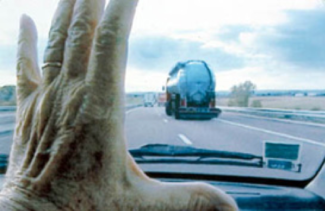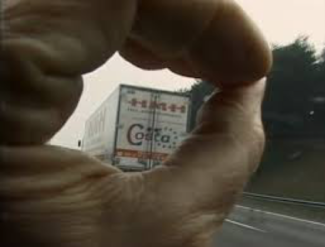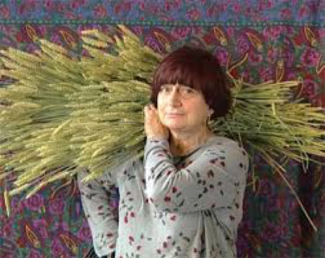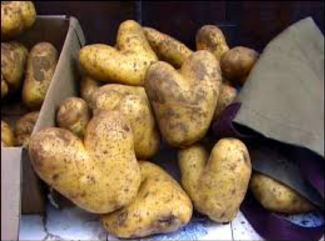For the Picking
Paper by Ceryna Baens.
 In a world driven by materialistic greed and the desire to have the newest and fanciest items, an abundance of high quality yet “outdated” goods go to waste. However, one man’s trash is truly another man’s treasure. The concept of gleaning, or scavenging, has made a resurgence. While historically gleaning referred to the gathering of leftover grain after the harvest, it has transformed into not only a means of survival but an art form. In the 2000 French film, The Gleaners and I, documentarian Agnès Varda travels through France and speaks with various new age gleaners, such as an artist, chef, and gypsies, to hear their stories. While this is not a narrative film, Varda uses repeated imagery of trucks to best convey her message. This is best demonstrated through a scene in which Varda is “catching” freight trucks with one hand and recording with another. An analysis of this scene and the film’s repeated imagery of artwork, trash, and trucks will show that The Gleaners and I implicitly denounces the wastefulness of society and proposes gleaning as the key to proactively supporting local people and the environment thus making a political statement about our current capitalist environment of excess.
In a world driven by materialistic greed and the desire to have the newest and fanciest items, an abundance of high quality yet “outdated” goods go to waste. However, one man’s trash is truly another man’s treasure. The concept of gleaning, or scavenging, has made a resurgence. While historically gleaning referred to the gathering of leftover grain after the harvest, it has transformed into not only a means of survival but an art form. In the 2000 French film, The Gleaners and I, documentarian Agnès Varda travels through France and speaks with various new age gleaners, such as an artist, chef, and gypsies, to hear their stories. While this is not a narrative film, Varda uses repeated imagery of trucks to best convey her message. This is best demonstrated through a scene in which Varda is “catching” freight trucks with one hand and recording with another. An analysis of this scene and the film’s repeated imagery of artwork, trash, and trucks will show that The Gleaners and I implicitly denounces the wastefulness of society and proposes gleaning as the key to proactively supporting local people and the environment thus making a political statement about our current capitalist environment of excess.
 The Gleaners and I was filmed in 1999 in France by Agnès Varda and premiered at the Cannes Film Festival in 2000. In the film, she subjectively examines what it means to glean. As a filmmaker, she is a self-proclaimed gleaner, picking out and gathering images that best fulfill her narrative. Varda, now 89-years-old, is nicknamed the grandmother of the French New Wave (“Agnès Varda). The French New Wave is regarded as a time filled with an “explosion” of energetic, innovative, and self-aware films by French directors in the late 1950s and early 1960s (Flagg). Varda’s debut, La Pointe Courte, a fiction-documentary cross, is considered the unofficial first film of the New Wave. In her six-decade long career, Varda has established herself as a director with the feminist and political nature of her films. Her most recent documentary focusing on public art and the everyday people of rural France, Faces Places, received an Oscar nomination in January of 2018. She describes her style as “cinécriture”, a hybrid of the French words for cinema and writing (“Agnès Varda”). This is reflected in The Gleaners and I as she utilizes her new DV-camera, which she proudly shows off, to tell her own story as a gleaner and those she meets.
The Gleaners and I was filmed in 1999 in France by Agnès Varda and premiered at the Cannes Film Festival in 2000. In the film, she subjectively examines what it means to glean. As a filmmaker, she is a self-proclaimed gleaner, picking out and gathering images that best fulfill her narrative. Varda, now 89-years-old, is nicknamed the grandmother of the French New Wave (“Agnès Varda). The French New Wave is regarded as a time filled with an “explosion” of energetic, innovative, and self-aware films by French directors in the late 1950s and early 1960s (Flagg). Varda’s debut, La Pointe Courte, a fiction-documentary cross, is considered the unofficial first film of the New Wave. In her six-decade long career, Varda has established herself as a director with the feminist and political nature of her films. Her most recent documentary focusing on public art and the everyday people of rural France, Faces Places, received an Oscar nomination in January of 2018. She describes her style as “cinécriture”, a hybrid of the French words for cinema and writing (“Agnès Varda”). This is reflected in The Gleaners and I as she utilizes her new DV-camera, which she proudly shows off, to tell her own story as a gleaner and those she meets.
 The Gleaners and I was awarded Best Documentary of 2001 by the National Society of Film Critics, New York Film Critics Circle, Los Angeles Film Critics association, Boston Society of Film Critics, and New York Film Critics Online and received a four out of four stars by Roger Ebert (“The Gleaners and I”). In a diary-like manner, Varda interjects herself into the film quite often. The film begins with her reenacting Jules Breton’s painting, Woman Gleaning, by holding a bushel of wheat over her shoulder then symbolically dropping it and saying “I’m happy to drop the ears of wheat and pick up my camera”. This action immediately demonstrates that Varda identifies as a gleaner, her empathy for all gleaners regardless of their background, and her openness to having fun while creating art. Throughout the film, Varda meets several artists that glean through objects left on the street to use for their art pieces. Later in the film, she visits Trash is Beautiful, a children’s workshop where they turn junk into art. This volunteer effort demonstrates a community’s creative response to France’s trash problem and all gleaners’ ability to make the most of any situation. While there she poses the question: “Where does play end and art start?” Again, comparing gleaning to art. In terms of art, it is important to highlight the music used in this film. When creating the score for The Gleaners and I, Varda chose to include two rap songs to express her anger and rage towards watching people rummage through closed markets for food. In the press kit for the film, she explains that rappers are “familiar to the denunciations of injustice, racism, and everything going wrong” (“The Gleaners and I”). Similar to rappers, most gleaners are used to “everything going wrong” as their life situations have made gleaning a necessity, rather than a hobby. Varda utilizes the mis-en-scene to subliminally tell a larger story than what meets the eye.
The Gleaners and I was awarded Best Documentary of 2001 by the National Society of Film Critics, New York Film Critics Circle, Los Angeles Film Critics association, Boston Society of Film Critics, and New York Film Critics Online and received a four out of four stars by Roger Ebert (“The Gleaners and I”). In a diary-like manner, Varda interjects herself into the film quite often. The film begins with her reenacting Jules Breton’s painting, Woman Gleaning, by holding a bushel of wheat over her shoulder then symbolically dropping it and saying “I’m happy to drop the ears of wheat and pick up my camera”. This action immediately demonstrates that Varda identifies as a gleaner, her empathy for all gleaners regardless of their background, and her openness to having fun while creating art. Throughout the film, Varda meets several artists that glean through objects left on the street to use for their art pieces. Later in the film, she visits Trash is Beautiful, a children’s workshop where they turn junk into art. This volunteer effort demonstrates a community’s creative response to France’s trash problem and all gleaners’ ability to make the most of any situation. While there she poses the question: “Where does play end and art start?” Again, comparing gleaning to art. In terms of art, it is important to highlight the music used in this film. When creating the score for The Gleaners and I, Varda chose to include two rap songs to express her anger and rage towards watching people rummage through closed markets for food. In the press kit for the film, she explains that rappers are “familiar to the denunciations of injustice, racism, and everything going wrong” (“The Gleaners and I”). Similar to rappers, most gleaners are used to “everything going wrong” as their life situations have made gleaning a necessity, rather than a hobby. Varda utilizes the mis-en-scene to subliminally tell a larger story than what meets the eye.
Varda intentionally repeatedly films trucks zooming by on the road. In one scene, she briefing appears in the rear-view mirror holding her camera. Then she focuses on her hand which she curls into the shape of an ‘O’ to frame passing by freight trucks on the highway enroute to Noirmoutier island on the screen. The sky is cloudy and gray in the montage of her “catching” around 22 trucks with her hands. An inquisitive tune plays behind it. She says in French, “Capturing trucks to retain things before they pass? No, just to play.” This scene best encapsulates the film because her child-like playfulness, gray hair, and aged hands gives a sense of nostalgia that is reminiscent to simpler times before capitalism was in excess. Using her own hand to reframe the shot, perhaps also signifies our ability to change our perception of the world. The music makes the viewer uneasy yet also curious enough to ask themselves: what if we could go back? Overall, the trucks emphasize the surplus of goods travelling across the country, creating an abundance of waste in the fields and streets. While Varda approaches the issue of overproduction and the high demands of consumerism lightheartedly, she also tackles the severity of homelessness and those who glean to survive.
 Although the film features people who glean for sport, leisure, or for frugality-sake, the film primarily highlights poverty within French society and the necessity of gleaning. Varda interviews multiple commoners throughout the film. Three gleaners interviewed throughout the film distinctly stand out. The first being Claude, a former truck driver, who she meets while he is gleaning for potatoes. His past occupation ties him to the reoccurring imagery of trucks. She soon discovers that of the 4,500 tons of potatoes harvested each year, 25 tons are thrown away for being too big in size. While some people like Claude reap the benefits of the “faulty” potatoes, some people are completely unaware of that they are legally able to pick through the oversized potatoes and use them. There have been volunteer efforts to mitigate food waste after the harvest, but there is a disconnect between the people and the government about the laws regarding gleaning as shown by the testimonies of people living in Claude’s trailer park and those gleaning for oysters in Noirmoutier. Claude gives Varda a tour of the trailer park he lives in which is significantly cheaper than renting an apartment. He explains that he was overworked which led to alcoholism then becoming unemployed, divorced, and then separated from his children. She emphasizes his resilience through the lens of gleaning and his ability to sustain himself despite all his losses. Claude can be perceived as someone who lost everything due to the high demands of capitalism.
Although the film features people who glean for sport, leisure, or for frugality-sake, the film primarily highlights poverty within French society and the necessity of gleaning. Varda interviews multiple commoners throughout the film. Three gleaners interviewed throughout the film distinctly stand out. The first being Claude, a former truck driver, who she meets while he is gleaning for potatoes. His past occupation ties him to the reoccurring imagery of trucks. She soon discovers that of the 4,500 tons of potatoes harvested each year, 25 tons are thrown away for being too big in size. While some people like Claude reap the benefits of the “faulty” potatoes, some people are completely unaware of that they are legally able to pick through the oversized potatoes and use them. There have been volunteer efforts to mitigate food waste after the harvest, but there is a disconnect between the people and the government about the laws regarding gleaning as shown by the testimonies of people living in Claude’s trailer park and those gleaning for oysters in Noirmoutier. Claude gives Varda a tour of the trailer park he lives in which is significantly cheaper than renting an apartment. He explains that he was overworked which led to alcoholism then becoming unemployed, divorced, and then separated from his children. She emphasizes his resilience through the lens of gleaning and his ability to sustain himself despite all his losses. Claude can be perceived as someone who lost everything due to the high demands of capitalism.
The second individual that stood out was a man named Francois that lives solely off of trash. He claims that he has not been sick in over 10 years, despite eating primarily discarded food. He explains that everyone regardless of their financial standing wastes food because “we are so stupid with food. If we’re past the sell-by-date of a yogurt, people go, ‘Oh my god! I can’t eat this!” The man is symbolic for our need to have the newest products, despite the ones we have still being good and usable. He claims to not go by expiration dates but by the food’s smell. One can’t help but wondering are produce companies putting early expiry dates on perfectly good food so we feel inclined to prematurely throw them away and buy more?
The third person is a man Varda finds shopping in the leftovers and trash after a French farmer’s market ends. In the weeks that she follows him, she finds out that he that he is homeless and lived in a shelter for eight years. He salvages through trash to find and fulfill his vegetarian diet and takes the train to Paris to collect bread in the evening. Most shockingly, this man has a Master’s Degree in Biology, yet sells magazines to make a living. Rather than letting his degree go to waste, he teaches other homeless people how to read for free. To me, this scene is symbolic to the measures people have to take in order to survive and the true spirit of gleaning: the notion of people who have nothing giving back to others just like them.
From superfluous amounts of vegetables and fruit remaining after the harvest to refrigerators lining the curbsides of France to the produce left behind after a weekend market, it is clear that the food waste problem and lack of governmental control was prevalent in 2000 when the film was made. This is best depicted in scene when a group of adolescent gleaners tell their story of how they vandalized a supermarket because the shop-owner poured bleach over produce in the trash cans so that they could not be picked through. In the eighteen years since its production, as of February of 2016, French parliament voted unanimously to fine supermarkets that throw away their products that are still edible or usable as animal feed. Larger supermarkets are to partner up with local charities so that food can go to the less fortunate, rather than thrown away. Despite all efforts, supermarkets and their partner charities still lack proper redistribution services and according to a recent study, only 24 percent of total surplus food ended up with the partner charities. The law fails to fulfill its purpose as a supermarket can redistribute as little as 1 percent of its surplus food and still be in compliance with the law (Gore-Langton). It has been almost two decades since The Gleaners and I was released and there are still necessary reformations to be made. Until then, the gleaners will continue.
While one can argue that “image contaminates reality” and that The Gleaners and I is biased due to Varda’s self-interjections, she is salient to both the story and to the people involved. In connection to Jefferson Smith in Mr. Smith Goes to Washington, Varda, herself an elderly woman, acts as a representative for the common man in this film. She is able to practice empathy and help viewers better understand the gleaners’ stories by relating to them. She does not implore viewers to pity the subjects of their film but to take note of the population of gleaners that making the most of their own life situations and the injustice they face. Varda successfully managed to “bring them out of their anonymity” and “discovered their generosity” (“The Gleaners and I”). She essentially is the voice of a group of people who have moved in silence for decades. Similar to The Lives of Others, this film encompasses art, passion, and creativity versus governmental control. While gleaning is not illegal because all items and produce gleaners find are intentionally thrown away, people, such as the supermarket owner that poured bleach on his trash, and the government attempt to inhibit gleaners from fulfilling their primitive needs. Whether they realize it or not, gleaners are a part of a movement to reduce our consumeristic greed. They are taking action and helping diminish the waste problem by putting disposed goods to use by turning them into their next meals or art pieces. This film is not only a political statement against France’s throw-away society but a message of resilience, resourcefulness, and creativity of a new age of people striving for change within their government. These people are the faces of a generation motivated to incite change in long-awaited policy and way of life. Where does gleaning end and change start?
Works Cited
“Agnès Varda.” The Criterion Collection, The Criterion Collection. 2018.
“The Gleaners and I.” Zeitgeist Films Release, Press Kit. Zeitgeist. 2000.
Flagg, Gordon. The Booklist; Chicago Vol. 96, Iss. 3, (Oct 1, 1999): 333.
Gore-Langton, Louis. “France’s Food Waste Ban.” Food Navigator, William Reed Business Media, 24 Mar. 2017.
About this entry
You’re currently reading “For the Picking,” an entry on Student Film Reviews
- Published:
- 02.24.18 / 3pm
- Category:
- Academic Papers, Films
12 Comments
Jump to comment form | comments rss [?]